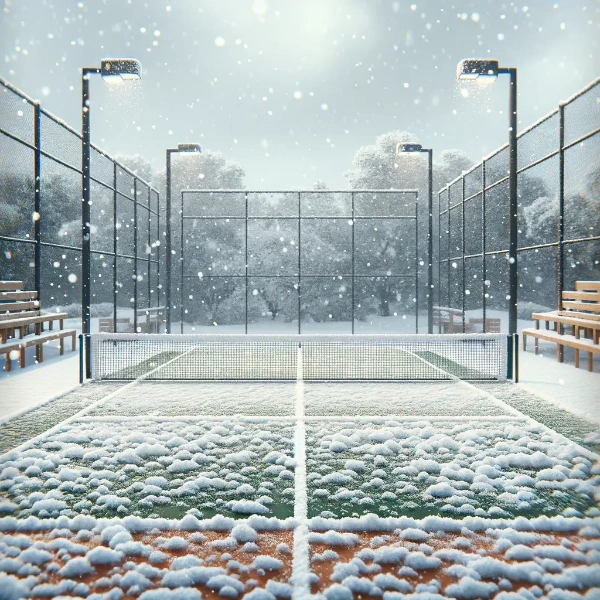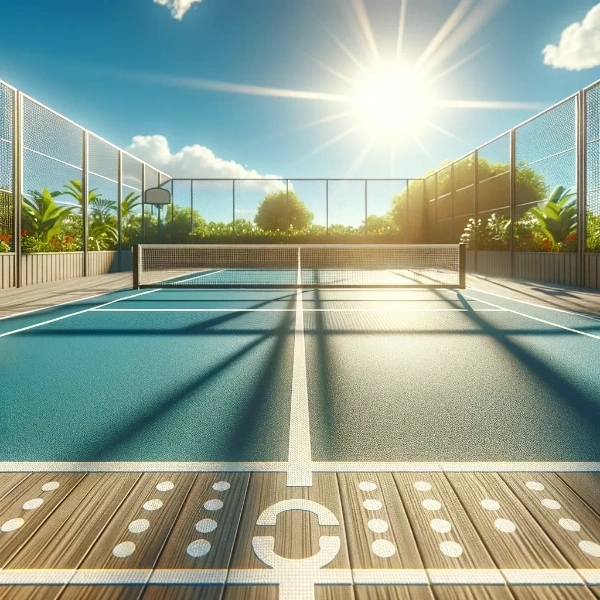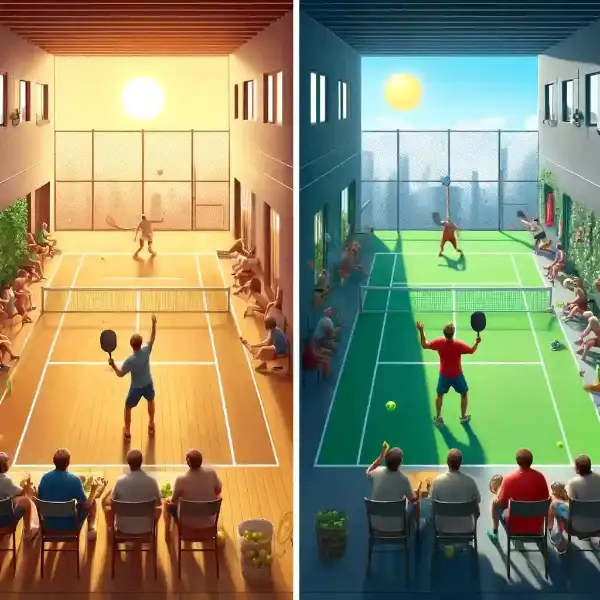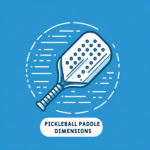When it comes to playing pickleball, one of the most common questions players ask is: what’s the difference between indoor and outdoor pickleballs? Understanding these differences is crucial for improving your game and ensuring you have the best playing experience. In this article, we’ll dive into the specifics of indoor vs outdoor pickleballs, helping you make an informed decision.
Table of contents
Difference Between Indoor and Outdoor Pickleballs
How Do You Tell the Difference Between Indoor and Outdoor Pickleballs?
The primary difference between indoor and outdoor pickleballs lies in their design and performance characteristics. Indoor pickleballs typically have fewer holes (around 26) and are made of a softer plastic. This design helps them to bounce less and have a more controlled flight indoors. Additionally, indoor balls tend to have a smoother surface, reducing their speed and making them easier to control.
On the other hand, outdoor pickleballs have more holes (usually 40) and are made of a harder plastic, which helps them withstand the elements and provides a more robust, faster game. According to the USA Pickleball Association, outdoor balls are designed to handle wind and rougher surfaces. The additional holes in outdoor balls help to reduce the impact of wind, ensuring a more stable flight path during outdoor play.
Comparison Table
| Feature | Indoor Pickleballs | Outdoor Pickleballs |
| Number of Holes | Approximately 26 | Approximately 40 |
| Material | Softer plastic | Harder plastic |
| Surface | Smoother | Rougher |
| Bounce | Lower | Higher |
| Durability | Less durable on rough surfaces | More durable |
| Wind Resistance | Less affected by wind | Designed to handle wind |
| Typical Use | Indoor courts | Outdoor courts |
Can Outdoor Pickleballs Be Used Indoors?
While you technically can use outdoor pickleballs indoors, it’s not recommended. Outdoor balls are harder and can skid on smooth indoor surfaces, making control more challenging. Similarly, indoor balls used outside can be affected by wind and may not bounce predictably. The difference between indoor and outdoor pickleball balls is significant enough to impact your gameplay. Therefore, using the appropriate ball for your playing environment is essential for optimal performance.
Do Indoor or Outdoor Pickleballs Bounce Higher?
Outdoor pickleballs tend to bounce higher due to their harder plastic and the number of holes. This can be a deciding factor for players who prefer a faster-paced game. The higher bounce and harder surface of outdoor balls can make the game more dynamic and challenging. Conversely, indoor pickleballs provide more control and less bounce, which is ideal for the typically smoother and less abrasive indoor surfaces. The softer material and fewer holes in indoor balls result in a more predictable and controlled bounce.
Choosing the Right Pickleball for Your Game
Practical Tips for Selecting Pickleballs
- Assess Your Playing Environment: If you primarily play indoors, opt for indoor pickleballs for better control and less bounce. For outdoor play, choose outdoor balls designed to handle wind and rough surfaces.
- Consider Durability: Outdoor pickleballs are more durable and can last longer on rough outdoor courts. Indoor balls, while less durable outside, are perfect for indoor surfaces.
- Experiment and Adapt: Try both types of balls to see which one fits your playing style and environment best. Some players may prefer the fast-paced nature of outdoor balls, even indoors, depending on their style.
- Check for Wear and Tear: Regularly inspect your pickleballs for cracks or damage, especially if you’re using outdoor balls, as they endure harsher conditions.
Why Do Outdoor Pickleballs Have More Holes?
Outdoor pickleballs have more holes to reduce the impact of wind and provide a stable flight path. The additional holes make the balls lighter and less affected by wind, crucial for maintaining control and predictability during outdoor play. This design feature is essential for outdoor games where wind can significantly influence the ball’s trajectory.
Practical Tips and Strategies for Indoor vs Outdoor Pickleballs

Enhancing Your Indoor Game
- Control and Precision: Focus on control and precision when playing indoors. The softer indoor balls allow for more strategic shots and placements.
- Surface Adaptation: Take advantage of the smoother indoor surfaces to perfect your drop shots and dinks. The controlled environment is ideal for practicing these skills.
- Reduced Bounce: Use the reduced bounce to work on your net game. Indoor pickleballs make it easier to anticipate and react to shots near the net.
Mastering Outdoor Play
- Adapt to Conditions: Outdoor play often involves dealing with wind and varying court surfaces. Practice adjusting your shots to compensate for these factors.
- Power and Speed: Utilize the faster, higher-bouncing outdoor balls to develop a more aggressive playing style. The robust nature of outdoor balls can enhance your power shots.
- Endurance Training: Outdoor conditions can be more physically demanding. Use outdoor play to build endurance and improve your overall fitness.
Improving Your Overall Game
- Regular Practice: Consistent practice with both indoor and outdoor balls will make you a more versatile player. Understanding the nuances of each type will give you an edge in any environment.
- Match Play: Participate in both indoor and outdoor tournaments to gain experience and confidence. Competing in different conditions will improve your adaptability.
- Equipment Maintenance: Keep your pickleballs and paddles in good condition. Regularly replace worn balls and check your paddle for damage to ensure peak performance.
Which is More Fun: Indoor vs Outdoor Pickleballs?

Indoor Pickleball
Indoor pickleball offers a controlled environment that many players find appealing. With consistent conditions, there are fewer surprises. No wind to carry your ball off course, no sun to blind you mid-shot. This predictability allows players to focus on precision and strategy. The softer balls used indoors provide more control, making it easier to execute perfect drop shots and dinks.
However, indoor play isn’t without its drawbacks. The noise levels can be quite high, especially in multi-court gyms where the sound of paddles hitting balls reverberates off the walls. Additionally, indoor courts often have multiple lines for different sports, which can be confusing. It’s important to know the layout to avoid stepping out of bounds inadvertently. Lastly, the proximity of walls and low ceilings in some indoor facilities can interfere with play, requiring players to adjust their shots to avoid these obstacles.
Outdoor Pickleball
Outdoor pickleball, on the other hand, is characterized by its dynamic and sometimes unpredictable nature. The elements—wind, sun, and varying temperatures—add an extra layer of challenge. The sun can be a significant factor, especially during certain times of the day. A well-placed shot can be missed simply because the sun was in your eyes. Wearing sunglasses and a hat can help mitigate this issue, and switching positions with your partner can also be a useful strategy.
Wind is another element that outdoor players must contend with. Even a light breeze can affect the flight of the ball, making it necessary to adjust your play style. For instance, hitting against the wind requires more power, while hitting with the wind calls for softer, more controlled shots. These adjustments can make outdoor pickleball a more physically demanding and strategic game.
Despite these challenges, many players find outdoor pickleball to be more exhilarating. The open spaces and natural surroundings provide a refreshing playing experience. The harder outdoor balls and the need for more powerful shots can make the game faster and more intense.
Comparison Table: Indoor vs Outdoor Fun
| Factor | Indoor Pickleball | Outdoor Pickleball |
| Consistency of Play | High | Variable |
| Environmental Factors | Controlled (no wind, sun, etc.) | Unpredictable (wind, sun, etc.) |
| Noise Level | Potentially high in multi-court settings | Generally lower |
| Court Markings | Can be confusing with multiple lines | Usually clearer outdoor-specific lines |
| Physical Barriers | Walls and low ceilings to watch out for | Open space, no low ceilings |
| Fun Factor | Precision and control | Dynamic and challenging |
Conclusion
Understanding the difference between indoor and outdoor pickleballs can significantly enhance your pickleball experience. Whether you prefer the controlled, softer play of indoor balls or the robust, faster-paced game with outdoor balls, choosing the right ball for your environment is key. Remember, the right equipment can improve your shot accuracy by as much as 5%, making your game more enjoyable and competitive.



